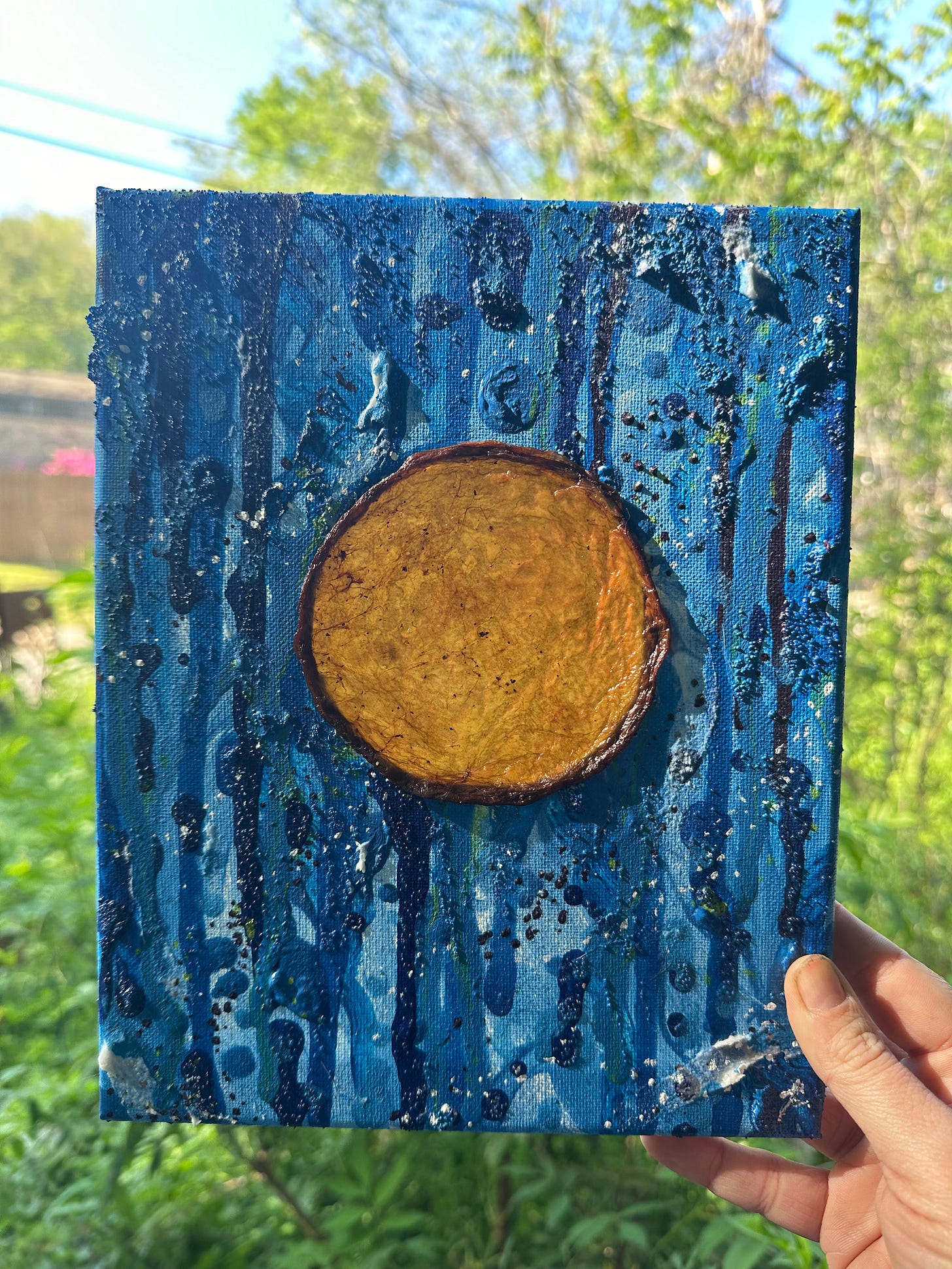For years, I’ve been experimenting with using kombucha SCOBY and vinegar mothers in artwork.
I always have them around, and because they exist in such constant abundance I have a rich source of artistic experimentation to play around with.
Since much of my current creative work is as a writer, food person, and entrepreneur, I sometimes forget that I literally have a graduate art degree and am also a visual artist.
The pleasure I get from this particular mode of expression is profound in ways that bring to mind an interaction I had years ago with my friend Doc, who would forget to stretch for long periods and then, when they would, would remember how expansive and delicious it felt. They always asked themselves in those moments “why would I deny myself this gift?”
I always draw, and do crafts, but especially when I get busy (or, in this moment, juggle which of my physical possessions lives on which continent) painting and book binding fall by the wayside.
So, this year has been a return to form with some of the more complex and public-facing types of artwork I like to create.
As part of that, I felt called to return to the SCOBY/vinegar mother window paintings I made a series of years ago, including this one that was part of the Save Your Spaces exhibition in Atlanta this spring (if you’re like ‘what is a window painting,’ they’re paintings with strategically cut holes so you can see through the translucent dried SCOBY).
Since this year is also the year where I’m being much more open and vulnerable about my work (like, the fact that I’m a critically thinking, science-loving PhD who also does energy work and art, and that all these things can exist in a person), I’ve also actually been open in discussing selling artwork too.
This has always been a point of vulnerability for me because with visual art in particular I wrestle with imposter syndrome more than in other areas of my creative/work life.
In any case, my artwork is for sale, and I’ve been enjoying sharing it with more folks publicly again.
The Center for the Book, who I did my graduate art training with (book art, I also did book history), are hosting an alumni show later this year that I’m a part of, so I’m reopening a chapter of my own life and skills that I don’t get to flex as often these days.
I wanted to bring my SCOBY art to the show as a sort of full circle moment: The UICB is where I first started working with food, art, and research in any sort of formalized way, with what became my first book on Gervase Markham’s 1615 The English housewife (you can still find my book that resulted from the project online).
I’ve also been thinking a lot about balance, particularly in a world that feels unbalanced, which led my mind to humoral theory as one aspect of the work.
Humoral medicine’s focus is on finding balance in the body between 4 humors (bodily fluids), which are impacted by diet and lifestyle as well as temperament. Humoral medicine emerged in Ancient Greece and Rom (this is also timely for Markham, too, though other medical theories were also coming to the foreground).
The exact balance one strikes is unique to that person’s body and makeup: But the same medical principles and best practices apply for all patients.
So how do I map these concepts into an artist’s book?
It turns out my obsession with little SCOBY windows was my friend here: Because I was able to make windows that will (once the book is done) each have one humoral element within them, building up to the complete and healthy person, living in balance, depicted on the final window.
This gives the piece a forward and interconnected movement too, because the windows show relationship between each of the balancing forces, and the final page being a window (not a solid sheet) suggests forward movement: In other words, that this balance is a continued conversation with ourselves and a continuous act of self care we engage in, not just a one-and-done affair.
The book is still in progress as I hit ‘publish,’ (I’ll post final images when it’s done), but it’s all bound up and I wanted to show you the early stages because the process component is, to me at least, one of the most important and interesting parts of engaging with another artist’s work. The video below shows the book in action:
The book will have additional layered components with homemade inks made from ingredients corresponding to each humor, plus illustrations on the SCOBY themselves.
Next up: I’m creating some more SCOBY paintings focused more explicitly on microbial interconnection and in at least one case, on reishi mushrooms. And, possibly binding a book made JUST from SCOBY, rather than SCOBY and paper.
P.S. I’m thinking of publishing a tutorial or doing a demo of how I dry and flatten my SCOBY for artwork.




